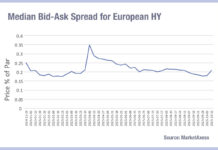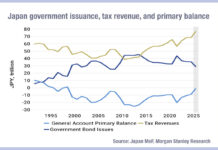 Fidelity International has homegrown internal expertise and tech, to support a fixed income trading team that can weather all markets.
Fidelity International has homegrown internal expertise and tech, to support a fixed income trading team that can weather all markets.
Lars Salmon is head of fixed income trading for EMEA at Fidelity International. He joined the firm as a senior trader in rates in 2011 and was promoted to his current role in January 2019. Previous positions held were as a director at Mizuho International between 2004 and 2011 and as vice president at JP Morgan between 1996 and 2004. In these functions he has traded and invested in most global financial rates products and has been involved in the building and running of rates trading teams.
The DESK: Who constitutes your team?
Lars Salmon (LS): Our team in EMEA consists of 11 traders and a trading assistant. They are split into areas of specialisation, mirroring the sell side. That approach is not only preferred because of the alignment with sell-side setups, but because our traders are heavily involved in the fixed income investment process and essentially offering an area of specialised expertise, where portfolio managers, by necessity, may need to be more generalist.
We have a diverse team, five of our 11 traders are female, for example, and diversity in general is obviously important in reflecting different experiences based on gender, background, nationality etc. This does reflect a company that is very proactive in this context, but it is pleasing to me, that diversity within fixed income trading developed entirely organically. We’ve never had any targets, our team evolved through the recruitment process from both internal and external candidates.
TD: How do you both engage with and lead your team?
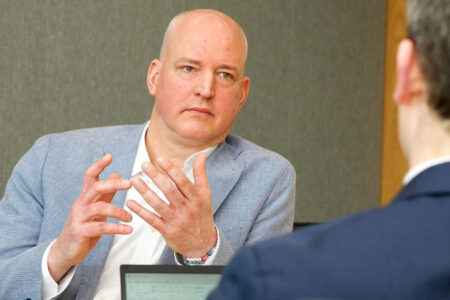 LS: One principle that matters to me more than anything is integrity and fairness. I’m looking for that in others, it’s only right I display that myself as much as possible. That means judging people by their merits, treating them equally and importantly, putting my hand up when I’ve made mistakes. I don’t think one can have much credibility without integrity, and without credibility one cannot have strong leadership. I had to learn not to micromanage, and delegation is a key part of the role for a head of desk. When I first took this role, it took me a little bit of time to get to that point and find the right balance between being on the desk, actively involved, but not being overbearing. Our traders are talented and have the required expertise to do the job very much without my active interference. Finally, despite the inevitable avalanche of meetings and committees, I try to remain close to the team and given that I worked with some of them as a fellow trader, I also don’t see any point in denying that history, i.e. my style maybe slightly different, relative to who I speak to, but hopefully never breaks the principles mentioned above.
LS: One principle that matters to me more than anything is integrity and fairness. I’m looking for that in others, it’s only right I display that myself as much as possible. That means judging people by their merits, treating them equally and importantly, putting my hand up when I’ve made mistakes. I don’t think one can have much credibility without integrity, and without credibility one cannot have strong leadership. I had to learn not to micromanage, and delegation is a key part of the role for a head of desk. When I first took this role, it took me a little bit of time to get to that point and find the right balance between being on the desk, actively involved, but not being overbearing. Our traders are talented and have the required expertise to do the job very much without my active interference. Finally, despite the inevitable avalanche of meetings and committees, I try to remain close to the team and given that I worked with some of them as a fellow trader, I also don’t see any point in denying that history, i.e. my style maybe slightly different, relative to who I speak to, but hopefully never breaks the principles mentioned above.
TD: Are you involved in day-to-day trading?
LS: I gave up the day job about two years ago; I help out when we’re short on the desk, and while I don’t really have an active trading role anymore, I have an active role on the desk, supporting, an element of guidance and advice where required.
TD: What do you do outside of work?
LS: I spend as much quality time as I can with my daughter, that’s a big part of every week. I play golf and spend time with friends – both those I met through the industry as well as those from other avenues in life.
TD: Which channels and structures do you employ to share ideas, insights and innovation between trading teams?
LS: We’ve been working as a centralised global trading unit for a number of years now but there’s still a very significant specialisation into asset classes. So fixed income trading is working within fixed income predominantly, just like the other trading teams mostly work within their asset classes. But I’d say we’ve made some great strides in terms of the group trading philosophy, i.e. cross-asset and global. That’s been accelerating over the last two or three years, with our global head of trading (GHoT), Steve Ellis, being very supportive. Through his engagement and the regular coming-together of the various heads of trading from different asset classes and regions, we helped to develop a global and cross-asset trading identity. To aid that we have regular global trading town halls, webinars, lunch and learn events, trader roundtables, and so on. Some of them are led by heads of trading (HoTs) or the GHoT, others by traders themselves. Ultimately those initiatives not only bring the heads of trading closer together, but also get traders across asset classes to become more familiar with each other and the specific asset classes.
TD: What is your perspective on multi-asset trading teams?
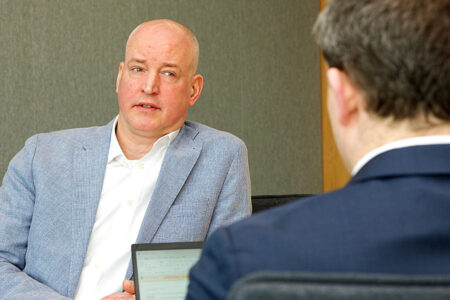 LS: We don’t have a multi-asset trading setup at this point, we still predominantly split trading into the different asset classes, as mentioned, and instead try to find relevant synergies. Those can be within the tech setup, or the consistency of workflows across asset classes and regions.
LS: We don’t have a multi-asset trading setup at this point, we still predominantly split trading into the different asset classes, as mentioned, and instead try to find relevant synergies. Those can be within the tech setup, or the consistency of workflows across asset classes and regions.
Sabina Awan, our head of strategic initiatives for global trading, has played a key role in identifying those opportunities. We think there are limits, of course, and that means we move forward sensibly, without forcing anything for the sake of it.. We also have a global trading analytics team, under James Anderson, who are cross-asset, cross-regional and by working with different trading teams, they have brought a lot of things together, such as ways of developing transaction cost analysis (TCA) in one asset class, for example, and bringing that potential over into another asset class. So, we have a centralised, global, trading team with specific asset class focus at an execution level, but at the same time driving and benefitting from synergies at a trading group level.
TD: Do you see risks in the multi-asset trading model?
LS: It may look very good on paper – and can undoubtedly make some sense in the most liquid areas such as Listed Derivatives and ETF, for example – but it does not only depend on the type of business that a firm mostly engages in, but also particularly on your tech setup. Our setup doesn’t currently lend itself to a cross- or multi-asset execution philosophy and so even if we wanted to, it would require investment to get to that point. But again, we are proactively pursuing other synergies we can identify as part of our global, cross-asset trading team setup.
TD: How are you positioning your team to evolve as markets change?
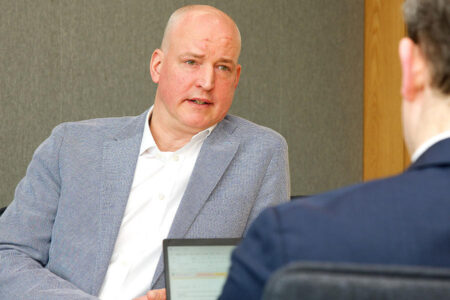 Evolving in one’s role should be a constant part of the journey and that in itself keeps traders on top of evolving markets. Whether it is trading protocols, new instruments, market dynamics or other matters, I believe in a two-way process – at times it might be myself pointing the team, or certain team members, into a specific direction, while at other times, it will be team members initiating and leading discussions on certain subjects.
Evolving in one’s role should be a constant part of the journey and that in itself keeps traders on top of evolving markets. Whether it is trading protocols, new instruments, market dynamics or other matters, I believe in a two-way process – at times it might be myself pointing the team, or certain team members, into a specific direction, while at other times, it will be team members initiating and leading discussions on certain subjects.
TD: How would you say your team supports better returns for investors?
LS: At the heart of it, is best execution. That includes the official context as it is referred to in regulation, but also our traders’ expertise and experience, together with the right trading technology and workflows. Our philosophy obviously makes best execution relevant for the individual transaction, but we also look at it in a much broader context, such as the value of relationship management as part of a best-ex philosophy.
Apart from that specific element of achieving best execution, helping the investor really means helping the portfolio manager who represents the funds and hence investors. The FI Trading teams’ involvement in the fixed income investment process is very deep and involves constant collaboration between trading, credit research/quant research groups, as well as the PMs, discussing trade ideas, timing of execution, and technical factors such as supply and demand – all the things one would expect in this context.
TD: Which trading technologies do you find most useful?
LS: The question of technology is very specific to each company and each trading desk. While dialogue within the asset management industry suggests that we all generally face similar problems, the solutions can be different.
Consequently, there isn’t a one-size-fits-all solution for your modern and sophisticated fixed income trading desks.
We have built a lot of technology ourselves. We invested a lot of time and resource over the years to create solutions. When looking at third party systems in the context of the question, it’s pretty obvious to me that the [FDC3] interoperability offerings seem to be quite popular, and they deal with a familiar problem for most of us, which is the management of multiple platforms, graphical user interfaces (GUIs), order management systems (OMSs) and execution management systems (EMSs) to create a more fluid trading workspace.
TD: Which functions does your in-house technology fulfil?
LS: We have developed a smart order router (SOR), which has several functions with the key one essentially a pre-trade decision tree, that assists traders with the low touch/high touch question. It also deals with the distribution of our wallet for listed derivatives, i.e. pre-populating counterparties on a rolling basis to achieve the fee distribution targets we define on a quarterly basis.
Separate from SOR, the other piece we successfully introduced is an internal new issue dashboard (NID).
Both SOR and NID address significant aspects of the everyday trading workflow to slightly different degrees.
The smart order router is a more mature product for us and has a broader role.
The internal new issue dashboard has been very helpful as well, but it’s only dealing with the internal aspect of the new issue process. Obviously, there’s a number of industry initiatives underway that we’re looking at and thinking about how to combine with our own internal developments. We do want to pursue connectivity with at least one external platform as a goal for this year.
 TD: Which asset class did the SOR develop in?
TD: Which asset class did the SOR develop in?
LS: It was developed for fixed income, going back five years and has the most significant influence in fixed income. It’s a proprietary tool that assists traders, specifically with the high touch/low touch question, as mentioned, where it brings in a number of static and dynamic parameters and then provides a RAG (red/amber/green) status with regards to the relative suitability of an order for automatic execution. The key factor for us is that the traders retain the power to make that ultimate decision. It creates the scalability that we’re looking for, and the ability to send lists of bonds or individual items down the automated route in a one-click fashion, where appropriate, but at the same time, retains the expertise and experience of the trader to make the decision. Certain functionality of that smart order router has also been rolled out into FX and equity teams. We also increasingly use the SOR’s flexibility to aid workflows away from order routing.
- It is unusual to hear of tech coming from fixed income into equity.
LS: Yes, when discussing EMS offerings, the somewhat frequent criticism remains that the vast majority continue to have gaps in FI. I’m not saying that we’ve resolved all of that, but it was that very reason that set us off on our journey some five years ago in fixed income, i.e. no appropriate external solution being available in our eyes.
TD: How does your team divide up, for example into handling high touch/low touch orders?
- The trading desk is split into areas of expertise. We have developed market rates and money markets; investment grade corporates and financials; a high yield desk; and we have an emerging markets (EM) desk. They are all specialists, in many cases have built up their expertise for years, and some have sell-side experience like myself.
Any order that comes on to the trader’s blotter has an indication with regards to its suitability for automated execution, essentially providing a suggestion wrt the appropriate route. As traders have become familiar with the automated functionality over time and SOR’s time, that suggestion is mostly followed.
A lot of progress has been made on the automation front and algo-trading front, but what was suited to automated execution yesterday may not be today. So, while we continue to try and develop that SOR and make it smarter, we still believe in the ultimate authority sitting with the traders.
TD: What are the greatest challenges your team faces and how will they overcome them?
LS: The requirements that we have around tech, resource and budget, in the context of the industry still evolving at a very rapid pace, or at a minimum, having a significant backlog after having developed at a significant pace, particularly in fixed income. Other asset classes are much more mature in the context of e-trading and automation. We see new protocols on an annual basis, sometimes more, and while that evolution is helpful and important, it means that for the buy side, we need to cater for that, i.e. build to it. That involves engagement with internal tech teams and often both venues and OMS (or EMS) partners.
Using a much wider lens, the build-or-buy option is often a key question. We obviously mostly chose to build in this context, which takes time, but the ‘buy’ option often also involves painful integration work. Evolution is obviously positive and we welcome it but it requires constant business as usual (BAU) investment and that has been a significant challenge.
TD: Are your personal challenges different?
LS: I often think about retaining talent. We’re very proud of the expertise and the talent within the fixed income trading team. We do have the benefit of providing a very credible avenue into fixed income portfolio management roles that has been well demonstrated, Of course, it’s not an option that applies to everybody, it’s not always available as it requires the relevant positions to be available. But it certainly gives us, compared to many of our peers, a way to provide that potential path which, of course, is very interesting to a number of traders.
TD: Looking at market conditions this year, what are your expectations for the rest of the year?
LS: A number of us expected more volatility this year. In many ways the Goldilocks scenario is still around and while it has been a busy start to the year in issuance, overall turnover is not that strong. I do expect a more volatile second half of the year. Risk assets appear to be priced to perfection at levels that might be difficult to be sustained, particularly in a world where a number of scenarios could still play out. Fed pricing, and general central bank pricing has changed materially over recent weeks and with markets now not pricing more cuts than the Fed, duration is in a better place again. 2024 is also the year of elections, with more elections than most of us can remember and probably none bigger than in the US towards the end of the year.
TD: Is the team already set up to handle that?
LS: The team is set up to handle whatever we find when we walk in on any given morning. That has to do with the way we hand knowledge and information down from the more experienced trader to the less experienced trader over time, and the close collaboration within. Our team also largely consists now of traders who have traded through the pandemic – arguably as difficult an environment as the more experienced of us can remember – and it hopefully gives them the sense that they can handle anything, within reason.
I would also mention relationship management in this context – is a significant part of the trading role and there’s plenty of evidence that more volatile times will also bring a bigger challenge to liquidity. It is in those times when relationships are most important and I believe we’re well set up to deal with those more volatile, less liquid times.
TD: How do you see the profile of counterparties changing?
LS: The arrival and subsequent growth of non-bank liquidity providers coming largely out of the exchange traded fund (ETF) space has brought a challenge to existing sell-side market makers in recent times. To a degree, they have brought new technology with them and newer protocols, such as portfolio trading, have accelerated with the growth of those firms. It’s generally been very much a positive influence. Still, it’s only a part of the landscape and to a large degree the FI market structure is still functioning the way it always did. It is mostly banks, and now some non-banks providing bids and asks to the buy side, selling bonds the banks often don’t have and buying bonds they often don’t want. Whether non-bank or a bank liquidity providers, the buy side still very much depends on those firms for liquidity provision.
Elsewhere, it’s pretty clear that over the last several years, the US investment banks have fairly well dominated capital markets and that is very much the picture we find in Fixed Income markets as well, A number of European firms have remained competitive, and will continue to be so, and regulatory challenges may potentially benefit some of them going forward in certain businesses.
We take relationship management with all our trusted partners very seriously and whether it is the regular provision of scorecards or indeed the more general dialogue, it will remain that way.
TD: How would you improve market function for the betterment of the buy side?
LS: As mentioned, the reality remains that the buy side in general does depend on the sell side for liquidity provision. That means, logically, that relationship management and working with the sell side is an important element. The sell side is quite open to working with the buy side and hence it’s mostly not ‘us against them’. We need to make sure that we work well with the sell side to create the optimal environment for us, which essentially means having the best possible access to liquidity at the best possible price. The industry may continue to evolve and over time, we may end up in a world that looks more like equity markets, potentially. That’s entirely possible. In the interim though, the aforementioned reliance on liquidity providers remains.
Some other, specific answers in the context of the question: The buy-side does discuss the relative reliability of inventory indications, or the lack of thereof, and as a general rule, the buy-side would hope for improvement here.
There is also a renewed regulatory focus on the concept of pre-hedging and to what extent that is helpful/beneficial to clients, or otherwise, and it is a relevant discussion.
TD: Which market structural changes keep you awake at night?
LS: Regulation is always at the top. The most immediate topic is T+1 coming into play in May. We’re not overly concerned in the context of fixed income trading specifically, but it certainly influences many other parts of the investment workflow. Often, regulation is designed with the best intentions, but can create nearer-term problems and also often requires a huge amount of investment from the private sector.
Other examples of future regulation, the European Union’s (EU) Active Accounts regulation will demand a certain split of our derivatives trading activity. We’re also looking at the impact of US Treasury and repo clearing. When the time comes, we will attribute resource and budget.
TD: What’s been the most impactful external innovation in bond trading over the last two years?
LS: There have been a number of new protocols, but portfolio trading (PT) has probably had the biggest impact. Over the last two to three years, its use certainly has accelerated in the market, becoming a very popular protocol. The key factors of timing and certainty of execution for a portfolio of bonds, as opposed to the opposite, line-by-line item execution, remain the primary motivation to use PT. The growth in portfolio trading is also related to the growth of the ETF market and PT in many ways can be thought of as the bridge from passive/index business to corporate bond trading.
TD: What are the limits and achievable wins of automation in bond trading?
LS: As discussed earlier, use of automation is widespread. Naturally, that starts with the most liquid aspects of fixed income; developed market rates instruments, followed by investment grade corporate bonds and financials. We have demonstrated achievable wins by introducing automation in fixed income trading many years ago, gradually growing and developing it, including introducing it sensibly into less liquid parts of the fixed income universe. But of course the less liquid spectrum in fixed income is where limitations to automation are most obvious, and that will remain that way for a long time
TD: How is it applied?
LS: Automation still requires a framework, which should be part of controls such as transaction cost analytics (TCA) to assess execution costs etc. At the heart of it, automated execution is an effective, electronic trading protocol that can provide very scalable solutions, but it is also essentially still a request for quote (RFQ) and should be looked at it in that way. Also, for the avoidance of doubt, automation and its sell-side counterpart of algorithmic trading, does not create new liquidity, it’s just a more efficient and faster way to make use of existing liquidity.
TD: How else would you say you’re innovating internally, to improve the efficiency and delivery of your trading desk?
LS: We work very closely with our relevant tech teams. There is a constant interaction around the needs of our trading team. We create priority lists as a combination between the trading desk’s desires, and what is deliverable. It’s an ongoing, constant process which reflects the relatively fast pace of evolution in our fixed income trading and any back log. As a principle, in this day and age, any trading business needs to have a strong, and competent working relationship with internal tech teams and needs to be able to clearly state the desired outcome that tech is expected to build towards.
TD: What do you make of the balance between intermediated and direct trading protocols?
LS: A lot of the small, run-of-the-mill business gets done via algos these days, but for more sensitive business, bilateral connectivity can be a digitised version of the current voice workflow. And in my mind, that is how some of the leading banks are thinking about it – an almost bifurcated setup where algos and automation dominate the small and more liquid space and bilateral connectivity can deliver on the other business.
It’s a complex issue though. The interaction between liquidity providers, who are predominantly sell side, and some of the trading venues, and ownership of those trading venues (which has changed at times) can affect motivations where some firms may or may not want to see business get done. Personally, I see pros and cons on both sides. For us, considering all aspects, being in the best possible position with our liquidity providers is important and at the same time, trading venues have done some great work and offer, in general, an elegant way of executing as you have access to all of your liquidity providers in one go.
TD: How does data play into this situation?
LS: Data unfortunately, remains a sticky subject in our industry as data is not available as easily as we would like and certainly not at the right cost point, especially as we play a role in creating that data. The question of data ownership is also an interesting one and I think that motivations for the direct connectivity vs venue question touches on a number of those things.
TD: How far up the priority list is increased primary markets efficiency?
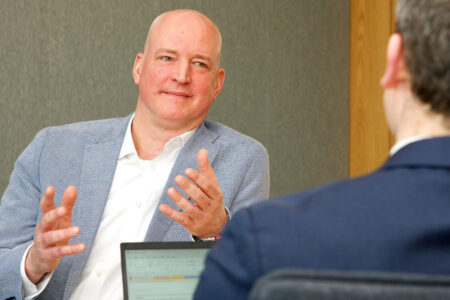 LS: It’s something we’re focusing on this year, if things go according to plan. The unfortunate element is that we went from no evolution in primary markets platforms to an immediately fragmented world of multiple players. It doesn’t do away with the fact that the evolution itself is very important, as for us, and for most our peers, issuance remains the most manual process that we have on the desk. That not only means that it is more time consuming, it also is more error prone. We’ve built this platform internally but the idea is ultimately to connect the two and have a much more elegant, effective, less manual workflow.
LS: It’s something we’re focusing on this year, if things go according to plan. The unfortunate element is that we went from no evolution in primary markets platforms to an immediately fragmented world of multiple players. It doesn’t do away with the fact that the evolution itself is very important, as for us, and for most our peers, issuance remains the most manual process that we have on the desk. That not only means that it is more time consuming, it also is more error prone. We’ve built this platform internally but the idea is ultimately to connect the two and have a much more elegant, effective, less manual workflow.
©Markets Media Europe 2024
©Markets Media Europe 2025


